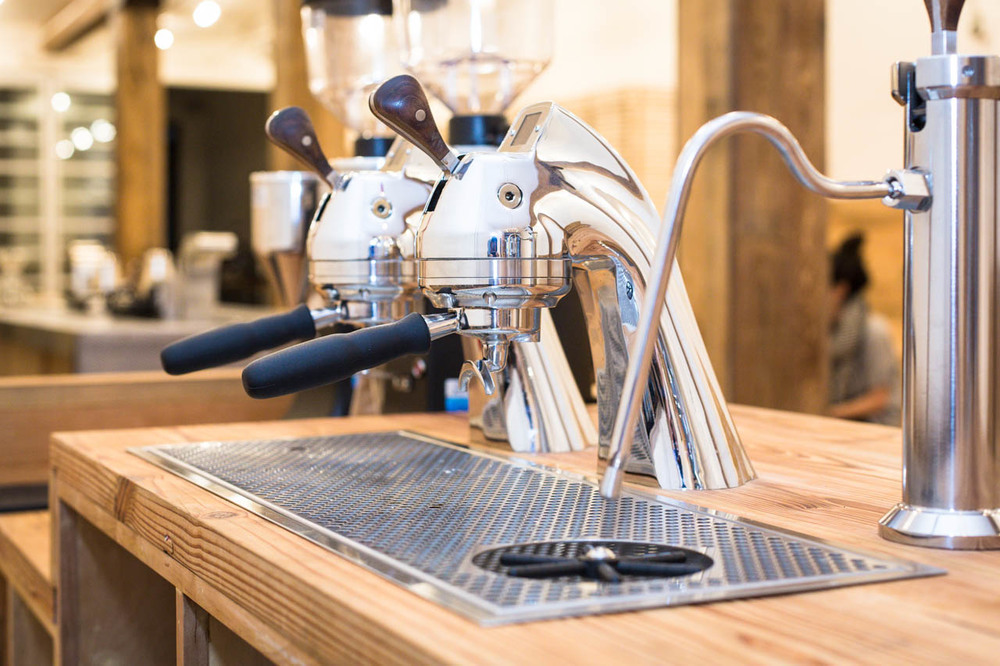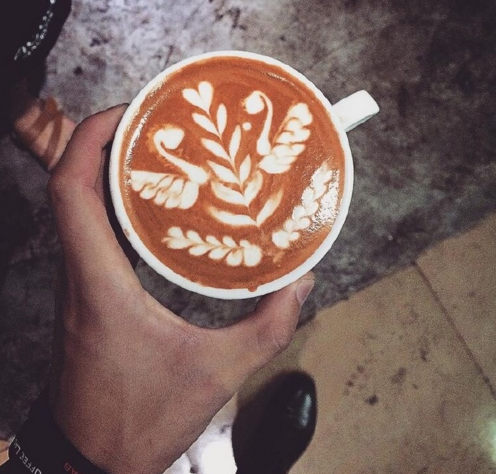Barista skills "Professional barista Handbook" the systematic exercise and workflow of baristas
Chapter V systematic operation of baristas
Tools that can improve efficiency
Busy cafes must take measures to improve efficiency, instead of foolishly making one drink at a time. More importantly, baristas must be trained to maximize their efficiency without affecting the quality of their products.
Using electronic control timer to control bean grinder
There are many advantages to use electronically controlled timers to control bean grinders. The timer ensures consistent powder output, reduces waste, frees baristas from performing other tasks during the grinding process, and improves the consistency of each cup of Espresso, even if it is made by different baristas.
In the purchase of timers, the author suggests that the accuracy to 0.1 seconds or less units, can be stepless adjustment is the best. No matter which timer you want to choose, first make sure that its voltage and current are compatible with your bean grinder.
Use a thermometer
Most baristas don't use thermometers, but they are wrong. The biggest problem with the "manual thermometry" they use is that the temperatures measured by different baristas are not the same, and even the same barista can deviate from the temperature measured by hand at different times, especially after repeated contact with the hot milk tank. The heat sensitivity of the fingers will decrease significantly. The solution is to buy high-quality thermometers, calibrate them once a week, and learn to use them correctly. "proper use" means that baristas must be able to predict thermometer readings while turning on steam. It is well known that there is a certain delay in temperature measurement by thermometers, but this delay can be expected. It is not difficult to master the delay when using different volumes of milk, as long as the thermometer reading reaches a few degrees below the target temperature, turn off the steam bar switch. For example, when using 10 oz (300 ml) milk, turn off the steam 10 ℉ (approx. 5.6 ℃) in advance; when using 20 oz (600 ml) milk, turn off the steam 5 ℉ (about 2.8 ℃) in advance.
I wonder why so many baristas think they are more accurate than calibrated thermometers. The goal that all baristas should always keep in mind is to make consistent high-quality products, and no matter how skilled they are, they can only add icing on the cake. Just as violinists never rely on their own ears and use tuning forks, baristas should use thermometers in addition to their own feel and sound when measuring the temperature. To ensure consistency, each cafe sets a standard temperature for all kinds of drinks and trains baristas how to reach this temperature with the help of a thermometer.
Baristas who refuse to use thermometers can try to beat several jars of foam by hand to see if their perceived temperature matches the calibrated thermometer. In the case of continuous mass production, the above tests should be carried out to see how perception decreases when multitasking. If the test results show that there are differences in the temperature measured by hand, it is time to consider using a thermometer.
To make it easier to use thermometers, baristas can use a trick I stole from my friend Brant (owner of Princeton Small World Coffee): use pliers to bend the middle of the edge of the vat inward and drill a small hole in the bend just enough for the thermometer probe to insert. By doing so, the clip of the thermometer can be removed and the thermometer can be fixed in a convenient position.
↑ bends a small area on the edge of the tank and drills a small hole in the bend just enough to hold the thermometer probe.
Use the platform for milking
When the barista foams, the milk jar is held in his hand to complete the expansion process, and the milk tank can be placed on a platform to complete the rest of the foaming process. This is unorthodox for some baristas, but I think it's okay. Or you can place the vat on the platform to complete the entire expansion and foaming process, although it is often difficult to get the perfect foam.
After practice, this way of liberating the hands can also make good foam, and can improve the barista's operational errors or play unstable factors. As long as it is handled properly, there is no difference between beating milk foam and holding a milk jar.
The position of the drip tray of some espresso machines is itself suitable for foaming, while others need an object that is heavy and can be easily moved under the steam bar as a platform.
The ↑ foam platform should be heavy enough, but easy to move. After the steam rod is straightened, the steam sprinkler should be about 0.5 inch (about 1.3 cm) away from the bottom of the milk tank.
Work flow
Busy cafes should implement effective processes to deal with the situation of making multiple drinks at the same time. The process needs to be structured and flexibly adjusted when different numbers of baristas work together. Most importantly, the production process must be made on the premise of maximizing efficiency and not affecting the quality of the product.
Efficient process of single barista configuration
As before, the author will outline the efficient process when there is only one barista working below. In this example, one 180 ml cappuccino and two 240 ml lattes will be made simultaneously using injection Molding and foam sharing.
1. Turn on the electric timer and grind the coffee powder of the first cup of coffee.
two。 Put the milk into the 32-oz (960 ml) milk tank and fill it to half an inch below the mouth.
3. Remove the handle and knock it out, wash the boiled head, dry the powder bowl, and receive the powder.
4. As soon as the powder is finished, restart the electric timer of the bean grinder.
5. Complete the adjustment and powder pressing of the first handle.
6. Install the first handle, remove the second handle, and wash the head.
7. Knock out the second handle, dry, powder, adjust, and press powder.
8. Install the second handle and place a latte cup and a kabu cup under both handles.
9. Both boiled heads are turned on at the same time.
10. Deflate the steam stick and begin to beat the foam.
11. As soon as the expansion process is completed, the milk tank is placed on the platform.
twelve。 Restart the electronic timer.
13. Remove the third handle, knock it empty, and wipe dry.
14. Complete the filling, adjustment and pressing of the third handle.
15. Wash the third head immediately after the first cup and the second cup Espresso are finished.
16. Install the third handle, place a new latte cup under the handle, and begin to produce.
17. Put the first two cups on the counter.
18. When the expected temperature is reached, turn off the steam rod. Wipe the steam rod dry and deflate.
19. Pour approximately 1 ml 3 to 1 shock 2 milk into the second tank with a capacity of 600 ml, and then swap back and forth between the two tanks until the milk in the second tank is as thick as a cappuccino.
20. Finish the injection of cappuccino and deliver it to the guest immediately.
21. Continue to exchange milk between the two tanks until the amount and consistency of milk in the two tanks are agreed.
twenty-two。 Finish the injection of the first latte and serve it to the guest immediately.
23. Complete the third cup of Espresso.
24. Put the third cup on the counter.
25. Complete the injection of the second latte and serve it logically to the guest.
Through training, a skilled barista can get used to dispensing foam at the same time, grinding at the same time, and observing Espresso products at the same time. The author suggests that every barista should try his best to improve the work efficiency without affecting the product quality, and become more and more efficient over time.
Efficient process of dual barista configuration
Good cafes often require two baristas to operate the espresso machine at the same time, which can improve the speed of beverage production, but it can also lead to coordination problems. Normally, it is one coffee maker who makes the Espresso, and another barista who dispenses the foam and finishes the drink. The barista who works with milk has a difficult job, usually a "leader", planning the process and making decisions.
Baristas dealing with Espresso should make Espresso according to the needs of milk operators and be careful to make sure that the Espresso is eventually made into the right drink. If one of the baristas is behind schedule, you can ask another barista to help to maintain the coordination between the two. For example, when the barista who sends the foam is already a few cups behind, ask another barista to help with the foam and, if possible, help finish the drink to prevent any Espresso from oxidizing. After their progress is synchronized again, they can go back to their original posts.
The above just gives a framework of available processes. Although seasoned baristas can adapt to highly flexible processes, it is wise to use standard processes to avoid confusion.
(chapter 5 ends)

Important Notice :
前街咖啡 FrontStreet Coffee has moved to new addredd:
FrontStreet Coffee Address: 315,Donghua East Road,GuangZhou
Tel:020 38364473
- Prev

Barista skills "Professional barista Handbook" (5) how to play milk foam?
In terms of volume, milk is the main ingredient in most Espresso drinks. Because of this, milk should be handled as carefully as Espresso is extracted. Like choosing a coffee roaster, choosing a milk supplier should start from quality and blind testing. Sample cold milk and whipped milk foam first and taste them directly, then mix Esp.
- Next
Barista skills "Professional barista Handbook" (7) drip Coffee and hand Coffee
Chapter VI fresh Coffee drip Coffee has a bad reputation all over the world for many reasons. Many places sell light and bitter drip-filtration coffee that has been heated in a pot for a lifetime. Some boutique coffee suppliers also make the mistake of operating multiple types of beans at the same time, spreading down the inventory conversion rate of each kind of beans, making the beans stale as a result.
Related
- What is the meaning of lactic acid fermentation with coffee bean treatment?
- How to judge the state of foam by sound?
- How does the latte pull out the unicorn pattern? Come to get for a little trick to improve the flower pull!
- Will flower pulling affect the taste of the latte?
- Do you know the history of coffee?
- The difference between honey treatment and sun washing what is raisin honey treatment?
- What kind of milk can a novice use to make coffee foam to keep the foam longer? The correct method and skills of milking tutorial sharing
- Why do washed coffee beans taste sour? Flavor characteristics of washed Coffee
- Introduction to the skill of how to practice the size and height of water injection around the circle of hand-brewed coffee
- How do beginners practice coffee flower drawing from scratch?

